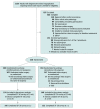Minithoracotomy vs Conventional Sternotomy for Mitral Valve Repair: A Randomized Clinical Trial
- PMID: 37314276
- PMCID: PMC10265311
- DOI: 10.1001/jama.2023.7800
Minithoracotomy vs Conventional Sternotomy for Mitral Valve Repair: A Randomized Clinical Trial
Abstract
Importance: The safety and effectiveness of mitral valve repair via thoracoscopically-guided minithoracotomy (minithoracotomy) compared with median sternotomy (sternotomy) in patients with degenerative mitral valve regurgitation is uncertain.
Objective: To compare the safety and effectiveness of minithoracotomy vs sternotomy mitral valve repair in a randomized trial.
Design, setting, and participants: A pragmatic, multicenter, superiority, randomized clinical trial in 10 tertiary care institutions in the UK. Participants were adults with degenerative mitral regurgitation undergoing mitral valve repair surgery.
Interventions: Participants were randomized 1:1 with concealed allocation to receive either minithoracotomy or sternotomy mitral valve repair performed by an expert surgeon.
Main outcomes and measures: The primary outcome was physical functioning and associated return to usual activities measured by change from baseline in the 36-Item Short Form Health Survey (SF-36) version 2 physical functioning scale 12 weeks after the index surgery, assessed by an independent researcher masked to the intervention. Secondary outcomes included recurrent mitral regurgitation grade, physical activity, and quality of life. The prespecified safety outcomes included death, repeat mitral valve surgery, or heart failure hospitalization up to 1 year.
Results: Between November 2016 and January 2021, 330 participants were randomized (mean age, 67 years, 100 female [30%]); 166 were allocated to minithoracotomy and 164 allocated to sternotomy, of whom 309 underwent surgery and 294 reported the primary outcome. At 12 weeks, the mean between-group difference in the change in the SF-36 physical function T score was 0.68 (95% CI, -1.89 to 3.26). Valve repair rates (≈ 96%) were similar in both groups. Echocardiography demonstrated mitral regurgitation severity as none or mild for 92% of participants at 1 year with no difference between groups. The composite safety outcome occurred in 5.4% (9 of 166) of patients undergoing minithoracotomy and 6.1% (10 of 163) undergoing sternotomy at 1 year.
Conclusions and relevance: Minithoracotomy is not superior to sternotomy in recovery of physical function at 12 weeks. Minithoracotomy achieves high rates and quality of valve repair and has similar safety outcomes at 1 year to sternotomy. The results provide evidence to inform shared decision-making and treatment guidelines.
Trial registration: isrctn.org Identifier: ISRCTN13930454.
Conflict of interest statement
Figures



Comment in
-
Valve Repair for Degenerative Mitral Regurgitation.JAMA. 2023 Jun 13;329(22):1922-1923. doi: 10.1001/jama.2023.9668. JAMA. 2023. PMID: 37314285 No abstract available.
References
-
- Otto CM, Nishimura RA, Bonow RO, et al. . 2020 ACC/AHA guideline for the management of patients with valvular heart disease: executive summary: a report of the American College of Cardiology/American Heart Association Joint Committee on Clinical Practice Guidelines. Circulation. 2021;143(5):e35-e71. doi:10.1161/CIR.0000000000000932 - DOI - PubMed
Publication types
MeSH terms
Grants and funding
LinkOut - more resources
Full Text Sources
Medical

